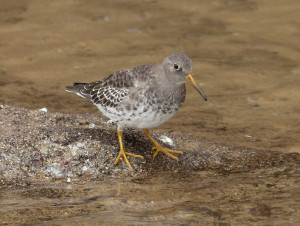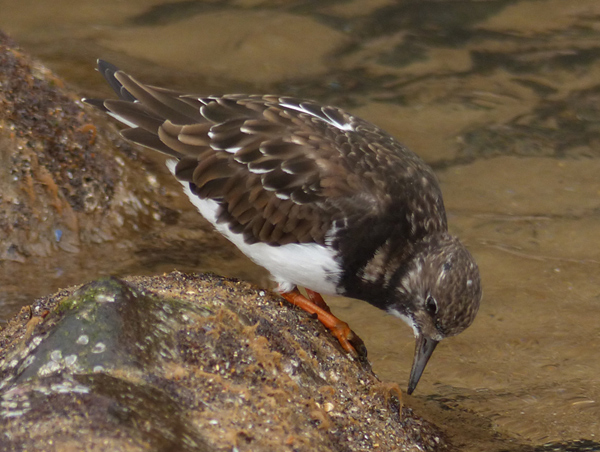
A few days ago I spent a morning birding around Bridlington harbour in East Yorkshire. This is often a good place for wintering and passage migrants, even in October, and is somewhere I used to visit regularly when I was at university in the area. One of the specialities of the site is Purple Sandpiper which can usually easily be found on the rocks around the harbour walls and I was hoping to be able to get close and take some photos. On a cold and breezy morning I got onto the south beach at low tide and quickly found a group of waders feeding on the rocks at the water’s edge which included Ruddy Turnstone, Purple Sandpiper, Red Knot, Oystercatcher and Common Redshank along with large numbers of gulls.Although a number of dog walkers in the area were causing a disturbance in the area I was able to pick a likely spot and wait for the birds to come towards me. The first of these were Turnstones, which in quite large numbers very soon ended up running around my feet and it was noticeable that quite a few of them had toes missing – presumably the older birds lose toes to the cold and discarded debris.
Purple Sandpiper is probably one of the hardiest shorebirds in Britain, spending winters on rocks around the coast battered by winds and waves, but in the shelter of the harbour wall seven of these birds were to be found feeding and after some time one of them came quite close to me; just standing still and moving slowly allowed them to ignore me and despite the poor light conditions I was able to get a few good photos.
Red Knot must be one of the most numerous wintering waders in the UK, certainly this would seem true when visiting estuaries around the country in winter, but usually views are a little distant so I was quite happy to come across two feeding alongside the Turnstones. At first they were quite nervous, repeatedly flying off when anyone in the vicinity moved but eventually they settled down to feed very close to me; I am sure I have never seen these birds at such close quarters before.
While I was concentrating on these birds I failed to notice the tide rapidly coming in and had to make a quick retreat, getting wet feet. I moved onto the harbour wall where I found a group of Redshank collecting behind the fishery office where they would roost.
With the tide in my attention turned to sea-watching, the bay at Bridlington being a good location for this and the end of the harbour wall makes an excellent place to stand and watch. In a short session I saw 4 Gannets, large numbers of Great Cormorant, 2 Guillemots, several Great Crested Grebes and a raft of 25 Common Scoter. On closer scrutiny it turned out that a Great Crested Grebe and a Slavonian Grebe were associating with this flock.
I moved further north along the bay to get another vantage point where I was able to get ‘scope views of a couple of Shags hunting as well as two Red-throated Divers with them for size comparison. Rock Pipit, 3 Razorbills and flocks of Fieldfare & Redwing were also nice birds as the rain began to fall and cut short my activities.


 October 30th, 2015
October 30th, 2015  Nick
Nick 



 Posted in
Posted in  Tags:
Tags: 










